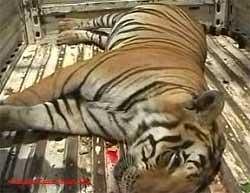
Little wonder that the whole world is crying itself hoarse over the sharp drop in the population of this endangered species from the Prime Minister Manmohan Singh deciding to step in to save the big cats and Environment Minister Jairam Ramesh making a wakeup call by blaming mafia supported by politicians for its extinction.
A UN's wildlife body, Convention on International Trade in Endangered Species (CITES) too in its ongoing meeting in Doha has noted that despite several years of efforts the world has failed miserably to protect tigers. "Construction and mining mafia do not want the tigers to survive in the forest. They want the land for construction of malls and mining," Ramesh said recently of the threat faced by the big cat in the country's 37 reserves.
He expressed hope that the Prime Minister's initiatives to talk to the states over the action needed to save the endangered species might help besides encouraging them to expedite notification process of buffer areas in protected areas and reserves to minimise impact on wildlife. However, even as the authorities deliberate over the reasons, tiger deaths continue unabated due to various reasons such as poaching, infighting and conflict with villagers.
On March 15, a tiger died in Tarai West, Ramnagar in Uttarakhand. During the same month, a total of four tigers died in Valmiki Tiger Reserve in Bihar, Ranthambore National Park and Wayanad in Kerala. In February, a six-year-old male tiger was found dead after being caught in a snare put up by suspected poachers in Corbett Tiger Reserve in Uttarakhand.
Loss of habitat for farming and human habitation apart, ever growing huge market for tiger parts and bone in the international front has been taking a heavy toll on this threatened species.
"If we use tiger numbers as a performance indicator, then we must admit that we have failed miserably and that we are continuing to fail," says Willem Wijnstekers, secretary general, CITES at the meeting where the illegal trade in Asian big cat products was a key discussion issue.
A ban on tiger parts was implemented in 1975, marking one of the very first initiatives under CITES, which regulates cross-border commerce in imperilled species. Tigers are listed in CITES Appendix I, which includes species threatened with extinction and allows non-commercial trade only in exceptional circumstances, such as for research. However, the animals are still poached, primarily for their skins but also for their bones and organs, used to make traditional medicines and supposed longevity potions, a demand arising from South Asian countries like China.
According to a latest report on wildlife trade in China by wildlife NGO 'Traffic,' porous borders are allowing vendors in Myanmar to offer a door-to-door delivery service for illegal wildlife products such as tiger bone wine to buyers in China which is observing 2010 as a Tiger year when the demand is feared to increase. "If no action is taken, sourcing from the wild coupled with increased captive production to meet an expanding market demand will pose a serious threat to wild species through unsustainable harvesting from wild populations in China and beyond," says Professor Xu Hongfa, Director of TRAFFIC’s programme in China in the report
"These animals don't have much time left unless we really get our act together," said John Sellar, CITES's senior enforcement officer, highlighting the gravity of the situation. "People are willing to pay to get the genuine articles, and so there are still practitioners who are buying tiger bones, tiger meat in order to supply their specialised clients," he says.
